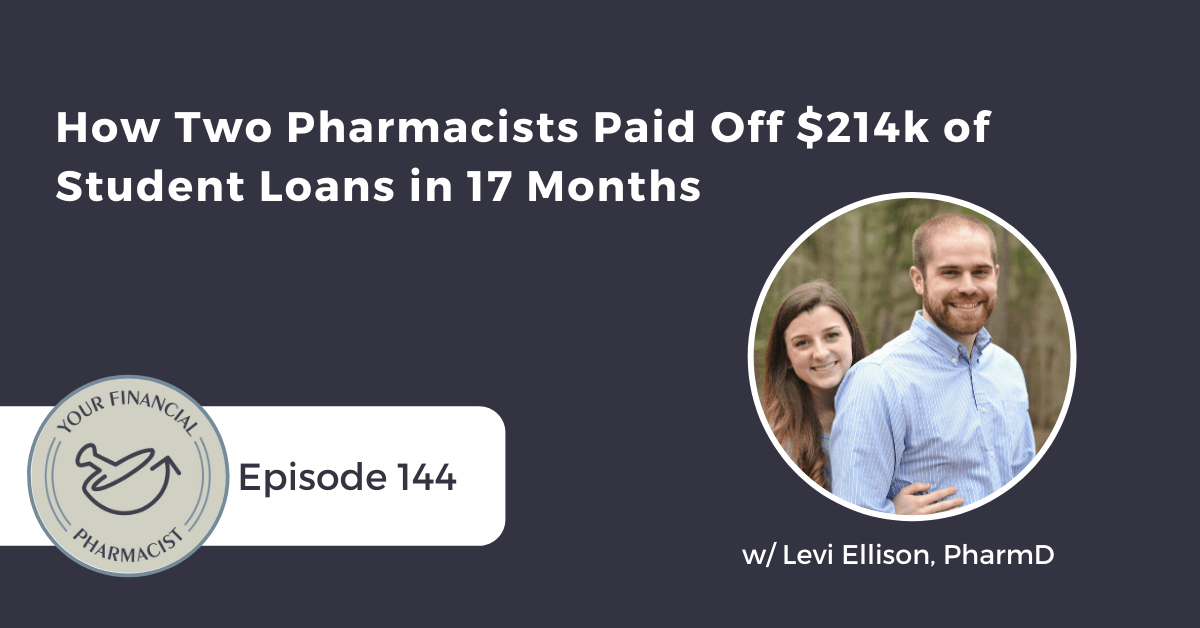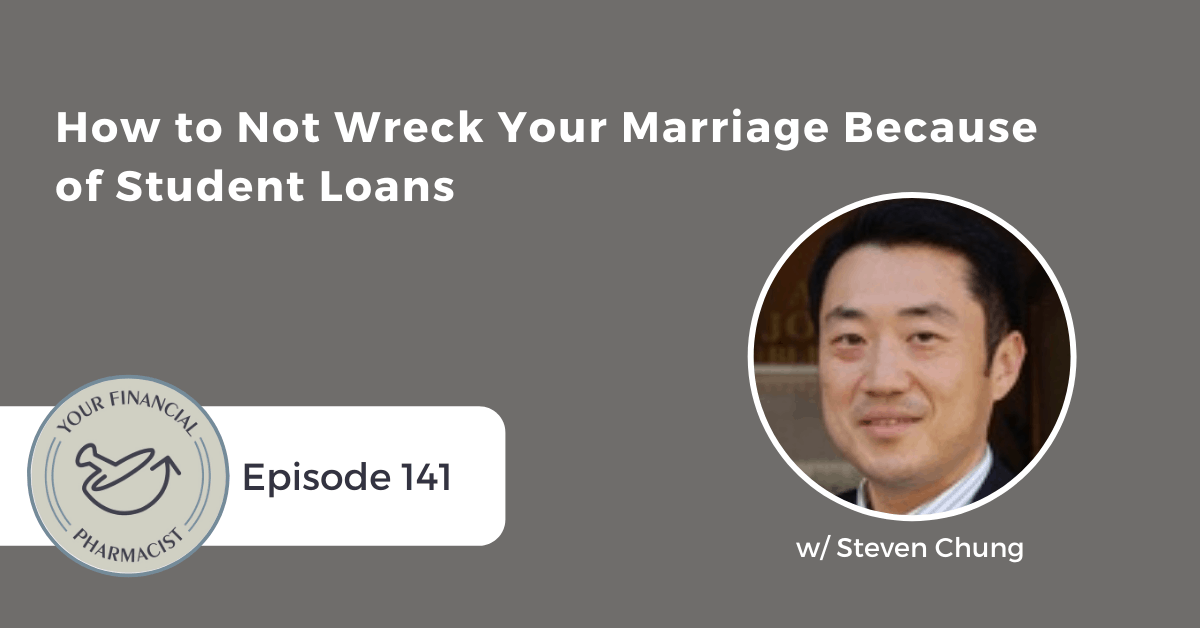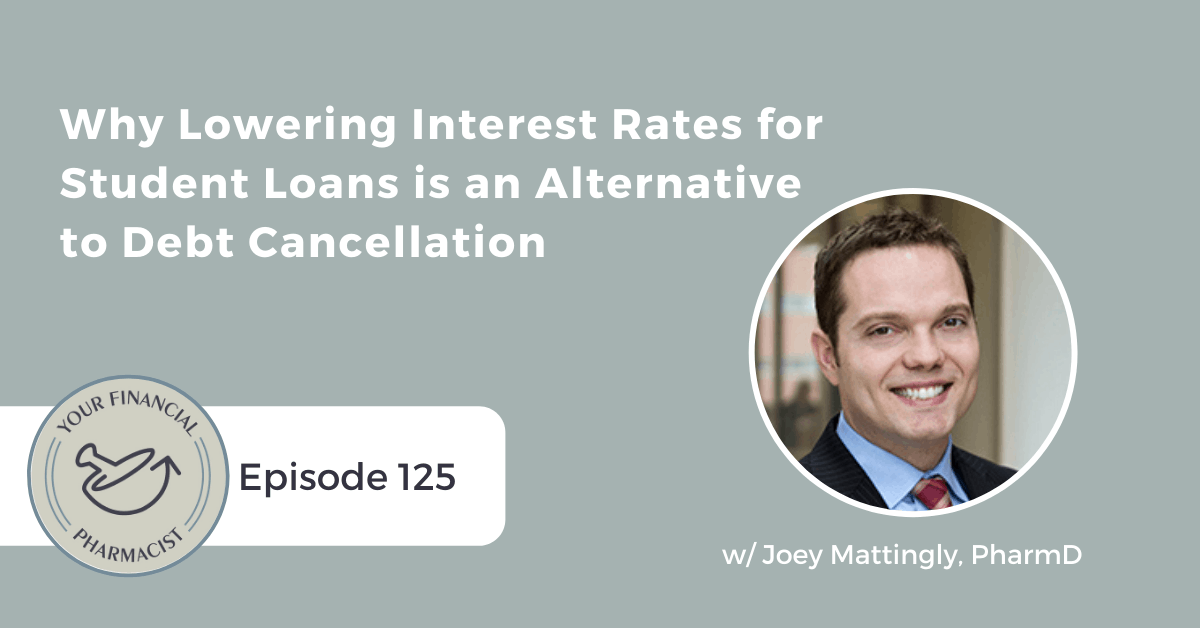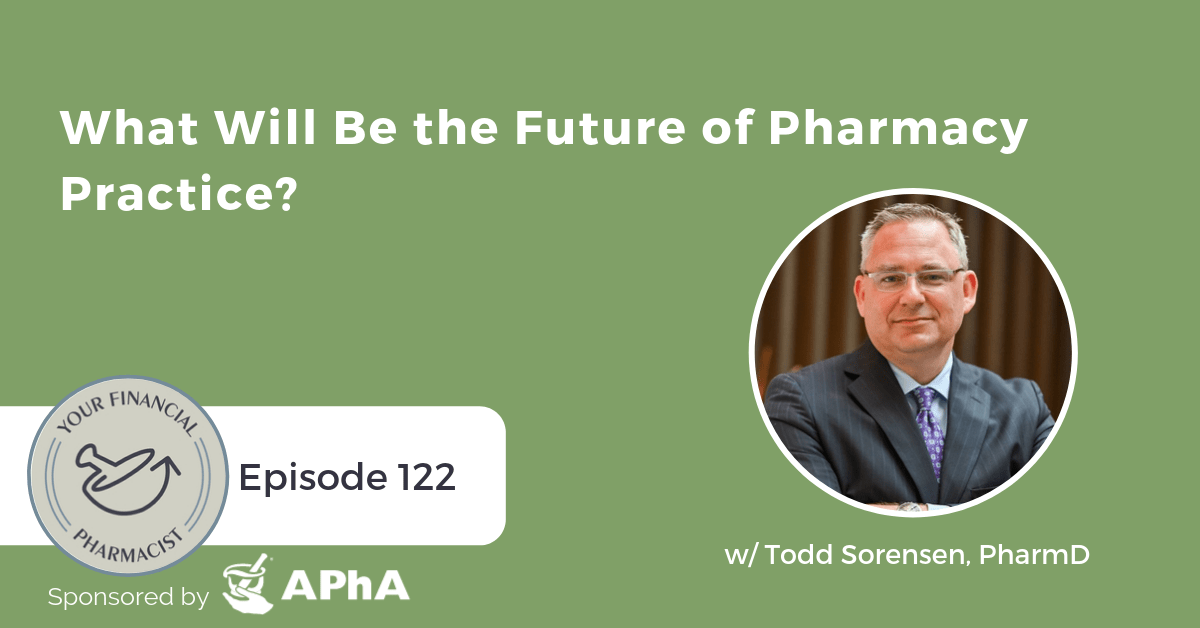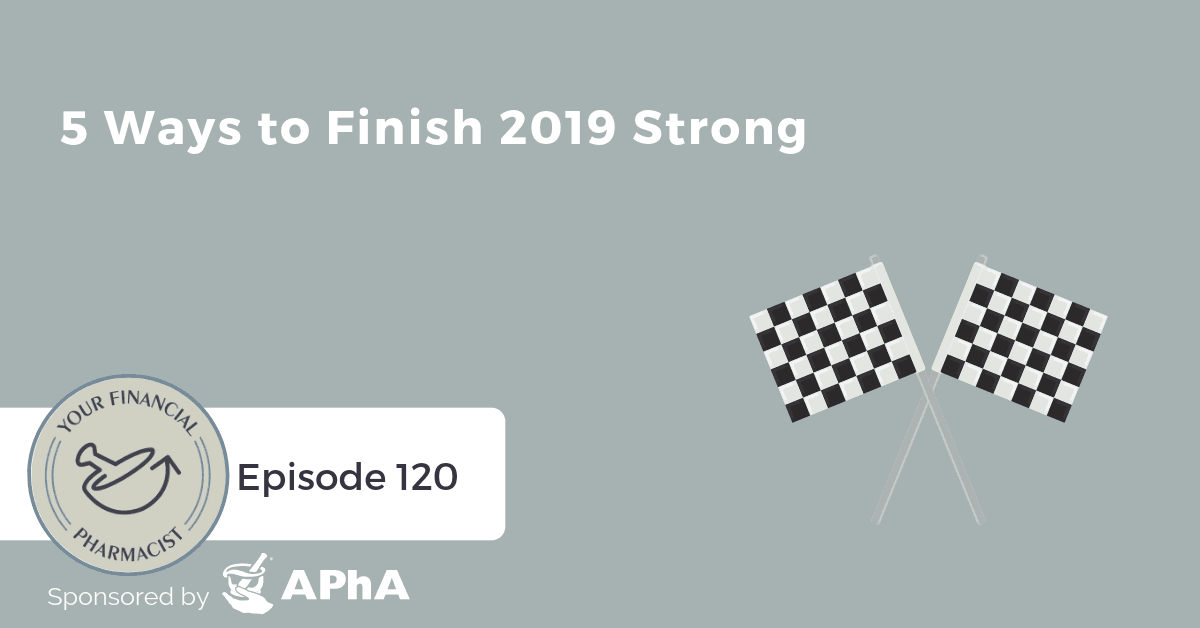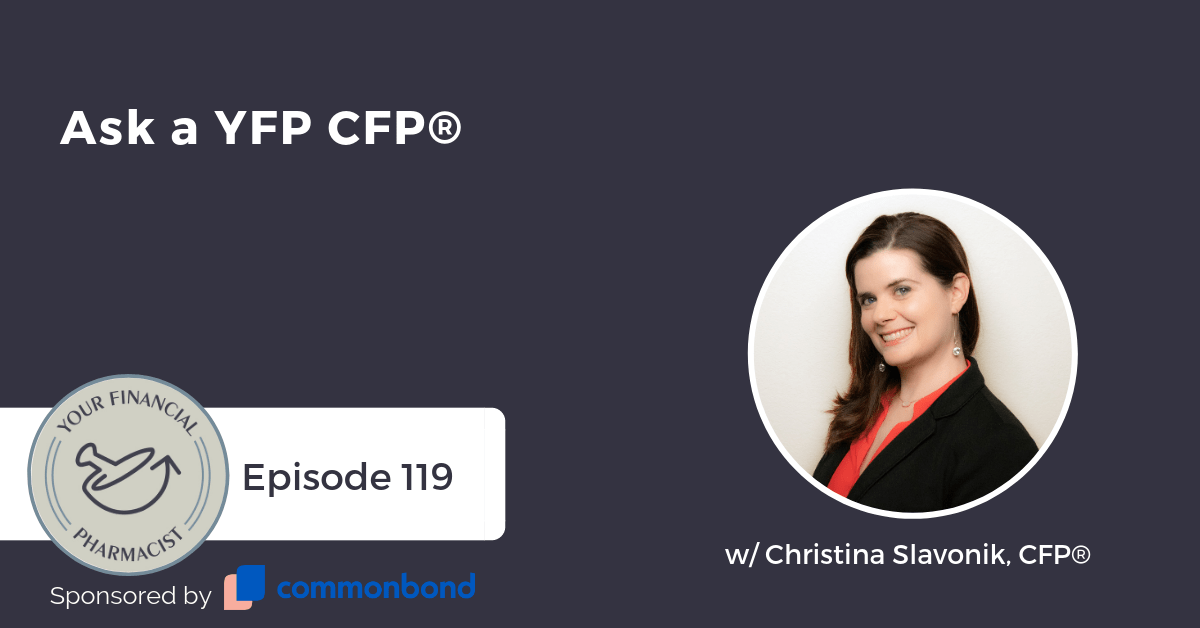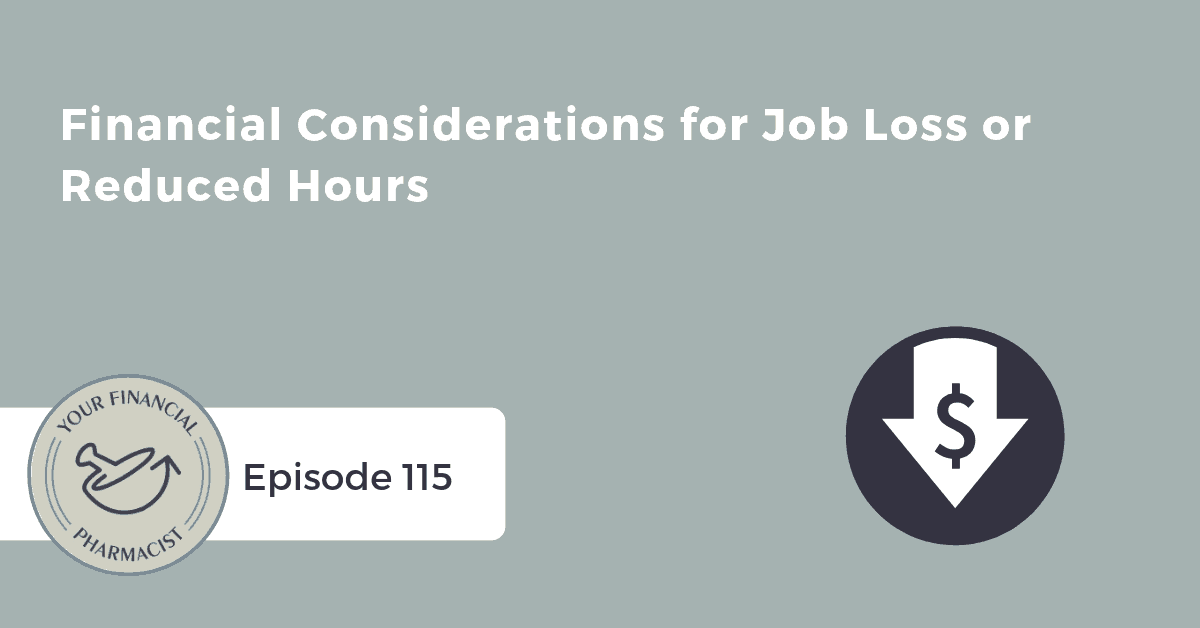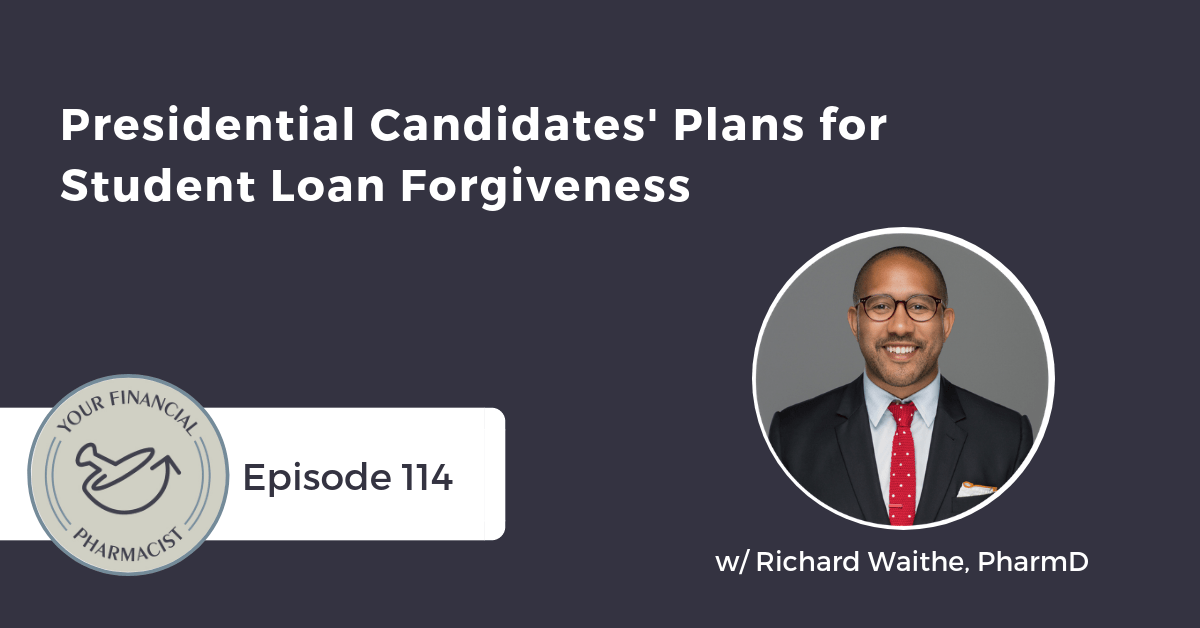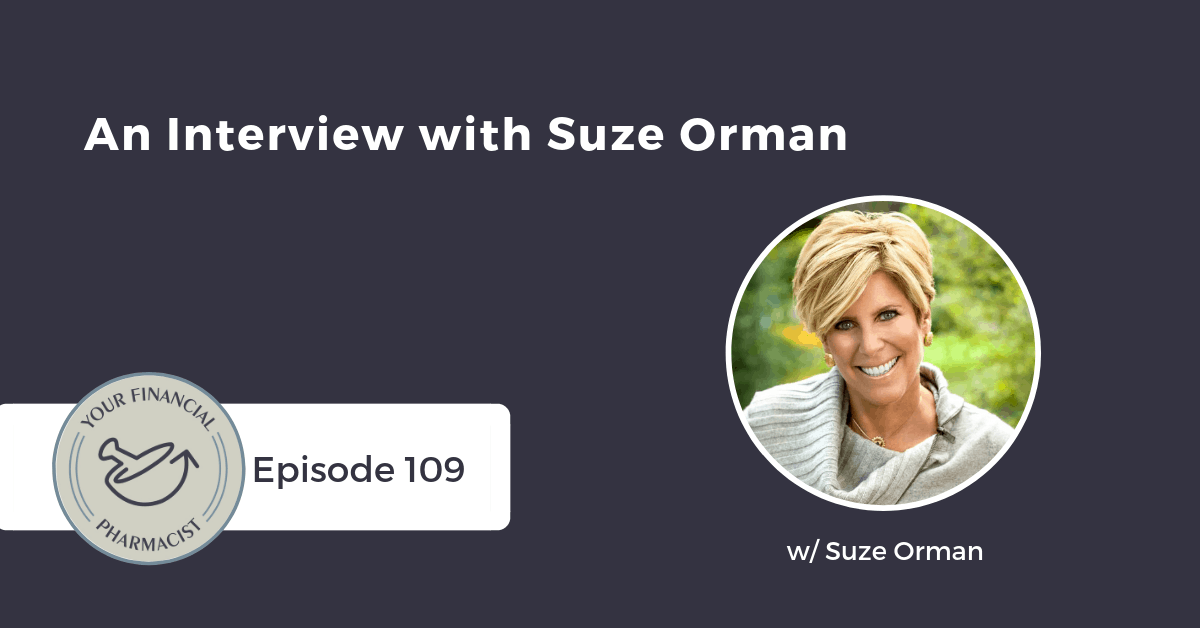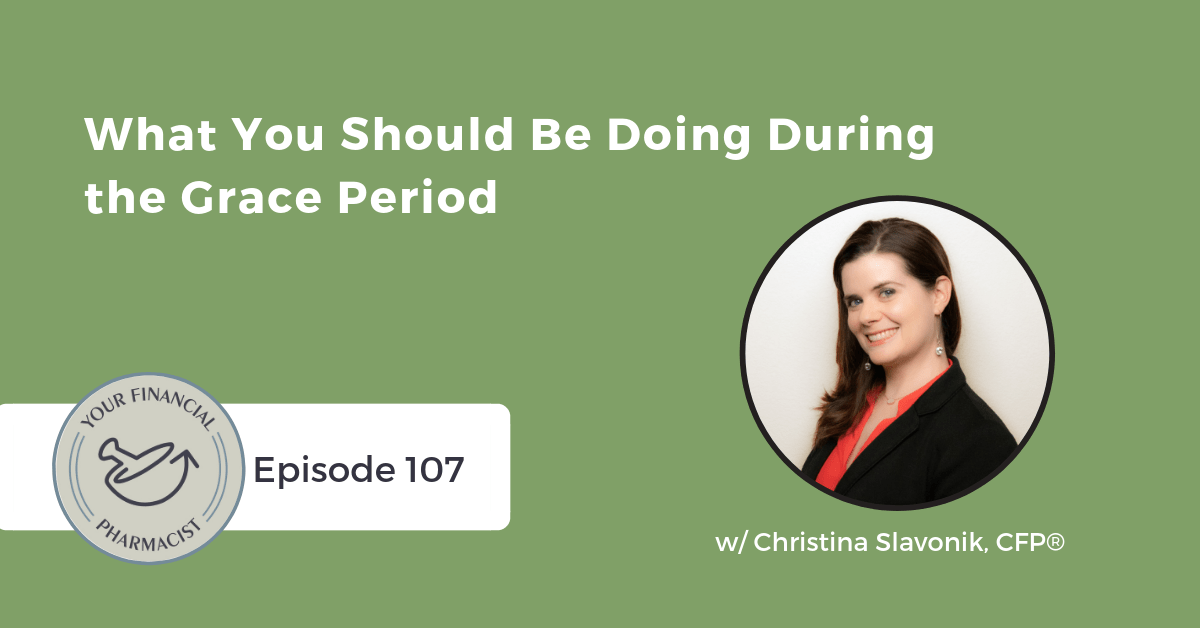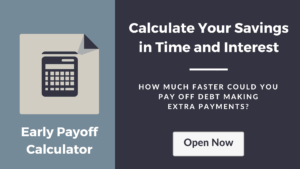How Two Pharmacists Paid Off $214k of Student Loans in 17 Months
Levi Ellison, PharmD, shares how he and his wife paid off $214,594.55 of student loans over 17 months. Levi talks about the motivations behind such an aggressive repayment strategy, how they were able to do it and what they hope to accomplish now that they are debt free.
About Today’s Guest
Levi Ellison has been married to his loving wife, Jessica Ellison, since the summer of 2018 following their May graduation from the University of Arkansas for Medical Sciences College of Pharmacy in Little Rock. While in pharmacy school Levi was a winning team member of the 2017 Good Neighbor Pharmacy National Community Pharmacy Association Pruitt-Schutte Student Business Plan. Immediately following graduation he received a $20,000 sign on bonus for a 2-year commitment to work in his hometown of Mena, Arkansas as a staff pharmacist at Walgreens. He serves as a Sunday school teacher for young adults at Salem Baptist Church, Treasurer of the Polk County Republican Committee, and served as a Financial Peace University Coordinator. He enjoys running, traveling with his wife, spending time with his family, and being debt free!
Summary
Levi Ellison shares his remarkable story of how he and Jessica, his wife who is also a pharmacist, paid off $214,594.55 of student loan debt over 17 months. While in school, Levi and Jessica were pretty aware of how much money they were taking out and knew that they didn’t feel good about taking out more than they needed. That mentally paired with some scholarships allowed them to both graduate under the average debt load that most pharmacists carry.
They were motivated by Joe Baker’s personal finance class in pharmacy school and by Dave Ramsey’s book Total Money Makeover. Following the Dave Ramsey approach, they knew that they wanted to attack their debt in a gazelle-like fashion so that they could move on to other financial goals that are important to them. By following a strict budget and using a budgeting app called EveryDollar along with a homemade allocated spending budget, they were able to pay off $214,594.55 in 17 months while tithing 10% of their gross income to their church. This payoff breaks down to:
$151,478.51/year
$12,623.21/month
$2,899.93/week
$414.28/day
Levi discusses how they worked together as a team to accomplish this goal and what their plans are now that they aren’t spending over $12,000 a month on student loans.
Mentioned on the Show
- PolicyGenius
- Total Money Makeover by Dave Ramsey
- EveryDollar
- I Will Teach You to Be Rich by Ramit Sethi
- Compass Money Map
- Financial Peace University
Episode Transcript
Tim Ulbrich: Hey, what’s up, everybody? Welcome to this week’s episode of the Your Financial Pharmacist. Excited to welcome Levi Ellison onto the show to share his debt-free story. Levi, welcome and thank you for taking the time.
Levi Ellison: Thank you, Tim. It’s great to be with you.
Tim Ulbrich: So grateful that you reached out to share your incredible story of paying off a lot of debt, a lot of debt, in a really, really short period of time. When I first heard about your story, you and your wife Jessica tackling over $214,000 of debt over 17 months, I thought to myself, wow, what an amazing accomplishment. And I can’t wait to hear exactly more of the details about how you accomplished this and why you were so aggressive in your repayment. And I’m excited to share this with the YFP community as well. So let’s start. Can you share a little bit of background about you and your wife Jessica, where you went to school and then ultimately the work that you’re doing now?
Levi Ellison: Yes. So my wife and I, Jessica, we went to the University of Arkansas for Medical Sciences. And that’s in Little Rock, Arkansas. We met in school there, pretty much simultaneously there and our church and in Sunday school. So we were in the same classes, we were in the same church, so we’re doing everything together and ended up getting married the summer following pharmacy school. And on our honeymoon, we got a — I received a sign-on bonus from Walgreens and that was a substantial figure and if you don’t mind me sharing, I’ll just tell the YFP community, it was $20,000. And that sounds awesome and it sounds great. It’s like, wow, you could put $20,000 straight towards loans. But once it hits your bank account, it suspiciously looked like $13,000.
Tim Ulbrich: The tax.
Levi Ellison: Yeah, yeah. It was terrible. But that day it hit our account on our honeymoon. As soon as we got home, we put that all towards loans. And that really got the ball rolling. And we were, you know, obviously very intense with the way we paid off loans just from the get-go and never looking back I think really set up a strong foundation for us.
Tim Ulbrich: So and I want to make sure our audience understands, so two pharmacists, obviously.
Levi Ellison: Yes. Right.
Tim Ulbrich: But nonetheless, as people start to translate this to their personal situation, something I mentioned to you before the show, is I did that for me, two pharmacists’ income, there’s only so much take-home pay. So when we talk about, you know, figures like $12,600 roughly per month over that 17-month period on average, that means there was a lot of sacrifice, a lot of cutting of expenses and obviously now you’re on the back end of that, and we’ll talk about the journey between, but nonetheless, two pharmacists’ income does not necessarily just mean that this was an easy path. And so I want to re-emphasize that. Now, one of the things, Levi, I often wonder is we don’t talk much about the accrual phase of the debt. You know, we talk about the debt paydown part of it, but for someone who clearly had very strong motivations right after school to get this paid off, I’m wondering, I’m guessing many of our listeners are wondering, well, what did you think about this while you were in school? Did it really dawn on you? Did it bother you? And as you look back, what strategies did you take or could you have taken to mitigate some of that damage rather than obviously what we’re going to talk a lot about as the payoff part?
Levi Ellison: Tim, that’s a fantastic question, no kidding. I love to answer that. So for me, during school, you know, the first time I signed up for a student loan was my first year of pharmacy school. I took out $20,000. And I thought, phew, this hurts, as I’m sure most of us experienced. I don’t think I like this. And I didn’t. And it started to wear on me. You know, your first year, you’re thinking, I’m just excited to be here.
Tim Ulbrich: Sure.
Levi Ellison: But as you — if you log in maybe once every couple years during pharmacy school and you look, you’re kind of shocked. And I was. And so they did a few small scholarships while I was in school, and I applied for those. Got $1,000 here, $1,000 there. But when you’re talking about the kind of numbers that pharmacy school costs, that’s just not a huge percentage. Every bit helps, but my fourth year of school, they have like a — I don’t know what you would call it — but an ultimate scholarship. It was $15,000 from UAMS that they give away to one student. And I applied for that, had to write an essay, and I got it. And that was really helpful, you know? I could have been more in debt than I was. And so I got that, and then I also applied for a rural scholarship where our Arkansas State Board of Pharmacy, if you’ll go and work in an area of I think it’s 15,000 or less people — I forget all the details. But I know my hometown qualified, and so I was like, I’m going to go back home anyway if they’re going to pay me to do it. I’ll take $15,000 for that and go. And so — it was $15,000 for the scholarship. I got $7,500 from the state board. And so that was over the course of a couple years of pharmacy school, so that helped mitigate some of my own student loans.
Tim Ulbrich: Sure.
Levi Ellison: And then my wife, I think she was fiscally conservative too. And I know she’s going to be listening to this. But I was able to get some of those things, and so that helped on my side. So it wasn’t like I just came out of school and suddenly noticed that I had debt. I mean, I was realizing this and had I known it while I was in undergrad — because we both came out of undergrad debt-free completely. And so that was helpful. But if I’d have really thought this through, I would have started earlier.
Tim Ulbrich: Sure.
Levi Ellison: So if there’s aspiring pharmacists out there that are listening to this show and wonder how they can get through school debt-free, be smart is going to be some of the things I’m sure we’re going to talk about as far as budgeting and saving and I wish I’d have done more of that earlier.
Tim Ulbrich: Yeah, and you and I both know from personal experience just how interest accrues on those loans, especially when you’re in graduate school, unsubsidized loans. And I think what you said is really profound — I felt the same way. You’re in school the first year, you’re excited about the opportunity, you’re not really thinking much about it or what this will be at the end. And what it sounds like, though, what I heard there, Levi, is that you guys really did some things in terms of scholarships and you mentioned the rural piece that allowed you to be in less debt than you could have been.
Levi Ellison: Yes.
Tim Ulbrich: I mean, if we look at the averages now, graduates today roughly $170,000. So if we’re going to multiply that by two, obviously you guys worked with a lot of debt, but you were for two pharmacist graduates, you were below the average when you combine the two of those together. So but I think wisdom there, you know, students that are listening, you know, that’s what we kind of always preach is hey, anything that you can be doing to minimize the amount that’s borrowed, even if it seems insignificant, you know, if it’s $18,000 a semester instead of $20,000 a semester, that compounds because of interest and multiple semesters over time.
Levi Ellison: Right. Yeah, if I could add one other tidbit to that, Tim —
Tim Ulbrich: Sure.
Levi Ellison: We both worked while we were in school. I think that’s important not only just financially but just learning. If you want to be a good pharmacist, I don’t think your first day behind the counter ought to be the day you get your license. And so that was helpful as well, clearly, for both of us.
Tim Ulbrich: Absolutely. Yeah, and I think that’s another good reminder, even if that hourly wage doesn’t seem super significant in the scheme of things, it adds up. I want to talk for a moment about the education piece — and a shoutout here to Joe Baker, who we’ve had on the show, has been long in the financial education space at UAMS I think teaching that personal finance elective course since 1999 and has had what I interpret to be a very profound impact on many students coming out of that program and his teachings. And I sense the same here. So tell me a little bit about that class, the personal finance elective that he taught. And what were some of the big takeaways and ultimately what impact that had on your own personal journey?
Levi Ellison: Yeah, so Joe Baker is a tremendous teacher. He gets in there and really makes the class engage. And that was a big reason I guess why I learned so much in there. And I do owe a lot of influence and credit to him for our story. That’s where we picked up the book “The Total Money Makeover” by Dave Ramsey and I’m sure we’ll get into kind of the steps of how we got out of debt, and that was very influential and we followed that to a T. But Joe, he — I tell you what, Tim, I mean, he cares about students and he cared about me and he still checks in with me from time to time. You know how you can sort emails on your phone or on your computer?
Tim Ulbrich: Yeah.
Levi Ellison: And I’ve got a separate little inbox for him and so I can read through all his financial stuff that he sends out, updates and things to do and not to do and just staying engaged with money. And it’s not like something that you read 24/7, but as long as you’re staying up-to-date on stuff, you can really make big differences. And we did, anyway. Yeah, love Joe.
Tim Ulbrich: Yeah. I sense he’s a great teacher and he’s actually working on a book right now and as I’m reading through it, I feel like it’s just spewing with wisdom of multiple years of experience and his teachings to many students along the way. One of the things you said in the email that you and I had connected prior to the interview was the impact of learning things like Time Value of Money and other things. And so I think this is again just a great reminder for students listening, if you have that opportunity like an elective if you’re in college, taking advantage of that. I think it just brings the topic front and center and develops that passion hopefully towards learning. But if not, going out there and finding it. You know, podcasts, blogs, sites that are out there, courses that are out there that can help you learn more about this. So let’s get into the x’s and the o’s. So I’m going to break down the numbers again of what you guys were working with. Total debt load — or excuse me — a total payoff of $214,594.55, but who’s counting, right, with the $.55?
Levi Ellison: Right.
Tim Ulbrich: And if we average that out a little bit more about $151,000 per year, a little over $12,600 per month, $2,900 per week, over $400 per day. That per day is the one that my gosh, when you see that number, you’re like, holy cow.
Levi Ellison: Yeah, that floored both of us because we didn’t realize because you don’t write that check every day.
Tim Ulbrich: Yes.
Levi Ellison: We wrote it every two weeks when we got paid.
Tim Ulbrich: So as I alluded to already, I see that number, $12,600 per month. Even on two pharmacists’ salary, that is incredible. There is only so much take-home pay to work with. So talk us through how you did it. It sounds like the baby steps were a big part of this. But even more details about the budget and kind of how you and Jessica worked together, really each and every month, and I’m sure it was even more often than that.
Levi Ellison: Sure. So I think budget is the key as far as how we were able to do it. More importantly when you get into kind of the nitty-gritty of how we budgeted, is we learned something called an allocated spending plan. And so every two weeks, I have a little Excel chart. I’m a big nerd, so I love looking at this thing. We, you know, just put the money in our checking account in the top line and then we subtracted everything else that was essential, you know, from electric bill, water bill, all your normal stuff, wherever your money’s going to go for the next two weeks. And then whatever money was left over, we immediately, as soon as that hit our checking account, we would put it towards the loan because we knew every day that was passing was about $30 in interest being added. And so if you do it one day sooner, you save $30. I mean, it’s not a full $30 because you’re not getting it all, but that mindset. And so that was how we did it is we just, we said these things are what we have to have. And I can tell you, Tim, over the course of those 17 months, we can count on one hand how many times we ate out on our dime. Our parents took us from time to time, her family would take us, mine would, you know, that sort of thing. But as far as just going even fast food, no. We planned very carefully. I can remember — and we bought a few things that we had to have or at least we thought we did like Jessica’s phone broke, so we went to the AT&T store and I can remember it’s about an 80-mile drive from where we are out in rural Arkansas. And we get there to the AT&T store and we’re like, should we eat lunch before we go in or after? We’re like, well, the food will probably get hot because it’s in the car in our lunch boxes. And so we’re sitting there, eating a sandwich in the AT&T store. We’re like, this is going to be worth it.
Tim Ulbrich: Yeah.
Levi Ellison: And I can tell you, it is so worth it now. We look back on that, we laugh, like that was so funny. And now when we go there for traveling, we can go out to eat and have all the chips and salsa we want, you know.
Tim Ulbrich: That’s right.
Levi Ellison: It’s fun.
Tim Ulbrich: And I think there’s something fun about the journey, right? I’m sure for you and Jessica, that brought you guys together in a different way and obviously I can tell just as I hear you talking, you’re reflecting on that together. It was something you accomplished together, and I think that’s a piece we don’t talk enough about is you know, from a marriage standpoint, two people working on something like that and making some sacrifices and working together, that has long, long-term effects, you know, obviously for the good. So I think that’s worth noting as well. Talk to me more about the budget. I’m guessing — I’m wondering, I’m guessing our listeners are wondering as well, it sounds like more of a zero-based budget kind of model.
Levi Ellison: Yes.
Tim Ulbrich: Accounting for every single dollar that you’re earning each and every month. You talked about an Excel spreadsheet.
Levi Ellison: Yes.
Tim Ulbrich: So was this something that you were leading the charge on? You guys were working together? Was it just staying in Excel? Were you utilizing any apps or tools to help you along that process?
Levi Ellison: Oh, those are all good questions. So we used EveryDollar, Dave Ramsey’s budgeting app. And we had the Premium version, and so it would sync with our phones as far as our — of course, we don’t have any credit cards. But it syncs with our debit cards and we could keep track of every single dollar that came out and came in. And that was kind of the goal for the month. And it gets a little confusing. Anybody that’s ever done a budget, you’re like, well, I still have money left over at the end of the month and I haven’t gotten paid yet for the next month. And so like if you’re sitting here, we’re recording this in March and I’m not going to get paid until April such-and-such date or whatever, you’re like, well, how do I budget for that? Because I’ve already got the money in my account, and so that’s where the allocated spending plan really came into play. And so we were on a two-week budget, even if we have goals for the monthly budget and we can throw that into that allocated spending plan, we can just say, OK, let’s spend a couple hundred dollars on clothes this month because we can now or whatever it is. And you take that and say, we’re going to spend it on this check here or you can do it over the course of a couple ones. And so that’s how we managed to keep track of everything. And as far as us doing it together, it was me doing the math and doing all the charts and stuff for the most part. But what I never did was make that finalized. We would come in together for sure every two weeks, and she would look at it and say, OK, I like this, don’t like this, and she would change a few things. But I’d have it ready for her to look at — at least I would try to. It doesn’t always work out perfectly.
Tim Ulbrich: So to that point, I mean, obviously to be able to pay off more than $200,000 in a very short period of time, two people have to be on the same page.
Levi Ellison: Yes.
Tim Ulbrich: But you know, I’m guessing that that doesn’t necessarily mean it was always perfect. Maybe it was.
Levi Ellison: No.
Tim Ulbrich: What was — yeah, what were some of those challenges? And for those that are listening that, you know, may be of a more extreme situation where instead of just a challenge here or there, it’s two people that philosophically — you know, maybe they don’t agree on the goals or the intensity of it. Any words of wisdom there you can share about either challenges you all had or words of advice for others?
Levi Ellison: I don’t think you could have asked a better question. So for two people to be married, you have to be on the same page about money. I don’t know how you couldn’t be. And so this is not something that I just sprung on our honeymoon. We had talked about this beforehand as part of our premarital counseling. And so we were on the same page. And so one thing about us as far as motivation and why would you be so intense about this is we want to be good stewards of what we’ve been given. And so to understand our worldview or our framework that we work in, we’re Christians, and so we’re very involved in our local church. And so along the way, I think this is important for your listeners — we weren’t misers, we gave 10% of our gross income. And so if you factor that in to —
Tim Ulbrich: Absolutely.
Levi Ellison: — how much money we paid back on loans, we could have been out of debt a lot sooner. But we also lived a lot cheaper than some of your listeners are probably thinking, now realizing that we factor in that we make average pharmacist salaries, $120,000-130,000 a year and there’s two of us. And we tithe 10% of that. We gave a lot of money to the church, and that’s not a bragging issue, but it’s something we believed in. And so that’s one of the reasons why we did this so quickly and aggressively and we were on the same page is because we both had the same faith and we both are on the same page about money, and we knew that we wanted to do this. And you’re right about strengthening marriage to go back to the previous question is it surely did. When we look at stuff now, we say, “Yeah, we could do that. That won’t be a problem.” Like we know we can. We’ve done a lot harder stuff together.
Tim Ulbrich: Yeah, and I think it goes back to you guys had that common thread, you had that common viewpoint, which even if there were moments of maybe month-to-month, you didn’t see eye-to-eye on everything, obviously in a short period of time, you did see eye-to-eye on a lot. But nonetheless, you still had that common lens in which you’re working from. And we always talk about I think the importance of starting with the goal, starting with the why, and then getting into the nitty gritty of the budget because if you can agree on the philosophy, if you can agree on the direction, it’s much easier to agree on OK, in light of the philosophy, let’s talk about this one expense or this one issue.
Levi Ellison: If there’s no why, you’re never going to get to the what of driving a beater.
Tim Ulbrich: Absolutely.
Levi Ellison: And I don’t really consider our cars beaters, but they’re probably worth about $3,000 apiece. And they run just fine. They don’t break down. They’re just little cars, and they do great.
Tim Ulbrich: So speaking of cars, a famous Joe Baker quote, there is not a parade watching you on the way to work.
Levi Ellison: Yes, I love that.
Tim Ulbrich: Which takes me to, you know, this concept of what decisions you guys made in terms of things to forego as you’re talking about making massive student loan payments or $12,600 a month, you’re talking about tithing, giving 10% of gross income throughout this, obviously you had to give up on some things, car being one I’m assuming. But home, other things, talk us through what were the areas that you decided not to spend money on that, you know, might have been difficult as you think about some of the challenges with kind of the peer comparison and keeping up with the Joneses.
Levi Ellison: Yeah. So I guess you could say we gave up on the car, you’re right about that. I’d love to be driving a brand new GMC Sierra. I would love it. But I’m not, and that’s OK. We’re going to pay cash for something like that one day or a slightly used one. And that’s fine because Joe Baker is 100% right. If you can get in the mindset of there’s not a parade watching you go to work, it doesn’t matter. And it’s kind of funny, people notice. One of my coworkers, one of the techs, her daughter asked her, said, “Why is Levi still driving that?” And she was sharing that with me, and it just made me laugh. Like they don’t get it. But you can share with them, say, “There’s a whole goal behind this. We want to be debt-free.” So that was one of the things that we gave up was car. As far as our housing situation, we haven’t bought a home yet. We’re renting, but we’re in a very good, quiet neighborhood. I love running, and so the streets are great for that, very little traffic. So I don’t really feel like we gave up much there. We’re living in a lot better place than the apartments that we both lived in Little Rock over the course of pharmacy school. You know, we have a backyard, a place for our dog, stuff like that. So we gave up a little. We don’t have a tremendous mountain view, we’re kind of in the mountains over here in Western Arkansas, and we look forward to that very soon. That’s one of the things that we’re saving for now. But I don’t feel like we gave up just a whole lot. We just didn’t have extensive dates.
Tim Ulbrich: Sure.
Levi Ellison: I was talking to my wife and said, “Do you want to share anything about that from your perspective on the show tomorrow morning?” And she said, “Well, we didn’t spend any money on dates.” I said, “That’s not true. I went to Redbox multiple times. I remember that $1.75.”
Tim Ulbrich: I was going to say, it started as a dollar, now it’s $1.75, right? So yeah. But there’s creativity there, right? I mean, again, those are moments that are created together. And I think I want to reiterate some of what you said. I mean, you know, used cars, renting, I think those are probably — if I had to pick two areas, no judgement here, but two areas that I would say often get in the way of being able to achieve other goals, here whether it is student loan repayment, but it could be any other goal, saving for retirement, saving for kids’ college, being able to give whatever, I would say it’s often the home and the car. And I think it’s shifting perspective that renting is not a bad thing. Renting is not evil, you know. You’re not necessarily just throwing money down the drain, and we talked about that on a previous episode with Nate Hedrick and really running the numbers objectively. And used cars, I mean, I think really changing your perspective on Point A to Point B, and one of the best things I heard on this was Ramit Sethi, who wrote a book, “I Will Teach You to Be Rich.” He talks about this concept of money dials. And identifying the things that mean most to you and align with your why and dialing those up. So let’s say for you and your wife Jessica, maybe it’s shared experiences together now that you guys have obviously a little bit more margin, spending money on that, not being afraid to spend money on that if that’s what means most to you. But if a car doesn’t mean a whole lot to you, then dial it down. Like you know what I mean? And find those things that really aren’t that important at the end of the day to you and really challenging yourself to think through those, each of those individually. So what do you say in response to, you know, some of the typical objections to the Dave Ramsey baby steps, right? So things like, you know, often only having $1,000 in emergency fund until you’re fully out of debt, and is that realistic, is that prudent. is that wise, you know, not to have a full 3-6 months? Or not establishing credit or building credit? Delaying retirement savings, perhaps? So what do you say? And I know your journey’s a little bit different because it was a shorter time period of 17 months, and I think where some of those challenges come in, especially on delayed retirement and emergency savings, is when you’re stretching it out say 5, 6, 7, 8, 10, 15 years. But talk to us through how you all reconciled that that was the method, the steps, the path that was best for you and your plan.
Levi Ellison: I would say first off, if you’re going to follow the Dave Ramsey plan, you can’t be Dave-ish. You have to either do it or don’t. And so we decided we were going to do it, and we were going to be gazelle-intense, as he likes to say. We’re running away on the plain from the cheetah, and we’re going to make it. And so we did. And as far as like the emergency fund, that’s a temporary emergency fund of $1,000. We now have 6 months of expenses and with a very real coronavirus running around right now, that makes us feel better. I mean, it truly does. And so to have to owe no debt to anybody and to be as prepared as you can be for a crisis like this or a pandemic to not want to be fear-mongering, but we feel good about that piece of our plan. And pausing retirement for 17 months, I mean, the stock market just lost the biggest loss in 30 years. I guess I think we’re OK for now. You know, it’s not like we’re not going to buy a house. It’s not like we’re not going to ever fully fund our emergency fund, those types of things. It’s quick. I mean, if you’re going to do it, you need to do it. And so for us, we knew each other well enough, we were in the same study group, we were very good friends before we got married or even started dating. And so I knew her, she knew me, we both knew if we said we were going to do something, we were going to do it. And so we just had that resolve. That’s kind of the way it went for us. But as far as like credit goes, we have a goal of having no credit. And that may sound crazy to a lot of people, but you actually don’t need it. I went down to my local bank, said, “Hey, is this going to be a problem if we have no credit?” And they said, “No.” And so it’s almost laughable how the way people think that you have to have a credit score. You don’t. I’ve rented plenty of cars without a credit card. I’ve done all the things that you need to do. I’ve booked a $12,000 cruise celebrating getting out of debt, and it got canceled because it was the Grand Princess that was quarantined off the coast of California.
Tim Ulbrich: Oh my gosh.
Levi Ellison: Right. Yeah.
Tim Ulbrich: Oh my gosh.
Levi Ellison: So there’s that. And that’s not a laughing matter, it’s a very serious thing.
Tim Ulbrich: Sure.
Levi Ellison: They’re going to reimburse us. We’re still waiting to hear back from flights, and so one thing I would change about my financial plan is buying insurance on flights.
Tim Ulbrich: Yeah.
Levi Ellison: I’ve never done that before, but I will be in the future because you never know what’s happening.
Tim Ulbrich: Although what are the chances of something like COVID-19, right?
Levi Ellison: Right, right, yeah. That’s what I said.
Tim Ulbrich: Yeah. So one of the things too that I heard there and I think often doesn’t get talked about, whether it’s the Ramsey framework or something like the Compass Money Map framework or another framework, I think a framework is very helpful, especially when you have multiple competing priorities that you’re trying to work through, debt repayment, retirement savings, emergency funds, and you’re looking at a way for two people to get on the same page. I think sometimes it’s a little bit more difficult if it’s one person’s idea and I want this other person to implement it, but I think sometimes a framework is a nice third party that gives you both an idea of something you can work towards together and hopefully have those shared goals. Last question I have for you is here you are now on the backside of this, and I think we often don’t talk about life after paying off debt. And what was $12,600 a month going towards student loans is no longer is no longer going towards student loans.
Levi Ellison: Right.
Tim Ulbrich: So what is the game plan now? What are the goals? And how have you adjusted to loosen up some of those things like hey, it’s OK to go out to eat, you know, every once in awhile, and it’s OK to enjoy those things. So talk to us a little bit about life after having the debt paid off.
Levi Ellison: Right, so this is a whole goal, right?
Tim Ulbrich: Yeah.
Levi Ellison: You don’t want to live below the federal poverty limit for 17 months and continue that until I retire. It’s not — that wasn’t the plan, so it’s exciting to be here and to like the cruise thing, we were spending $12,000 a month on loans and repaying that. We can book a $12,000 cruise, and it was going to be a really nice one, 11 days.
Tim Ulbrich: Yeah, yep.
Levi Ellison: And those things will work out in the future, and so we plan to take some trips. We want to go to Washington, D.C., want to tour the Capitol, do all the things that we wanted to do while we were in debt. And things, as far as having a framework, you are nailing it there. It is so important to have a plan. And so what we decided to do was to come up with like an annual budget. I know that sounds a little crazy for a household, but we have a year’s worth of plans and just kind of rough estimates, this isn’t as intense as our allocated spending plan as far as I know where every single penny is going. But we have plans in place to get us both vehicles, to have a certain amount of money in place to put a down payment on a home if we don’t end up paying cash for a home, which we might do. It depends on some different circumstances here at home, but having that annual plan in place I think is really going to help us, it’s already informing our decisions as far as when we get this money back from the cruise, what are we going to do with that, are we just going to go blow it anyway because it’s like it’s already gone or are we going to put and speed up the plan as far as well, if we go ahead and do this, we can get me a truck before summer, we can get her an SUV or whatever we want to do, which is a much more fun conversation than, ‘OK, it’s Friday again. Man, was that only two weeks ago that we paid $6,000? OK, here we go again.’
Tim Ulbrich: Another Redbox.
Levi Ellison: Push submit. Yeah, again at Redbox this week, that sort of thing. So it’s exciting to be able to talk about what we’re going to do with it versus we know exactly what we’re going to do with it.
Tim Ulbrich: And you know what I love, Levi, I know my wife Jess and I felt this, I sense the same for you and also a Jess is that when you are so used to grinding it out, I mean, $12,600 a month, for a 17-month period, it’s hard to measure, but there is such a long-term benefit of that beyond the 17 months. You know, yes, you’re going to loosen up the reins, yes, that’s OK, you guys should do that, you should enjoy it. And there’s balance and all that. But you’ve shifted that perspective on what really is important and where happiness does and does not come from. And I think that has such a long-term benefit beyond that 17-month period of how you’re utilizing your money. And I love that for you guys, I know you guys are teaching some of this now with Financial Peace, obviously giving is still a priority and really giving back and sharing some of that as you are doing here on the podcast as well. So really excited to see where this goes for you all and the impact you’re able to have on others because of obviously the margin that you have now to work with and the ability to share that. So thank you for coming on the show, thank you for taking time to share your journey. Congratulations. It’s really, really an incredible journey. And excited that you were willing to come on and share it with our community.
Levi Ellison: You’re very welcome. I enjoyed it.
Tim Ulbrich: Thank you.
Current Student Loan Refinance Offers
[wptb id="15454" not found ]Recent Posts
[pt_view id=”f651872qnv”]

